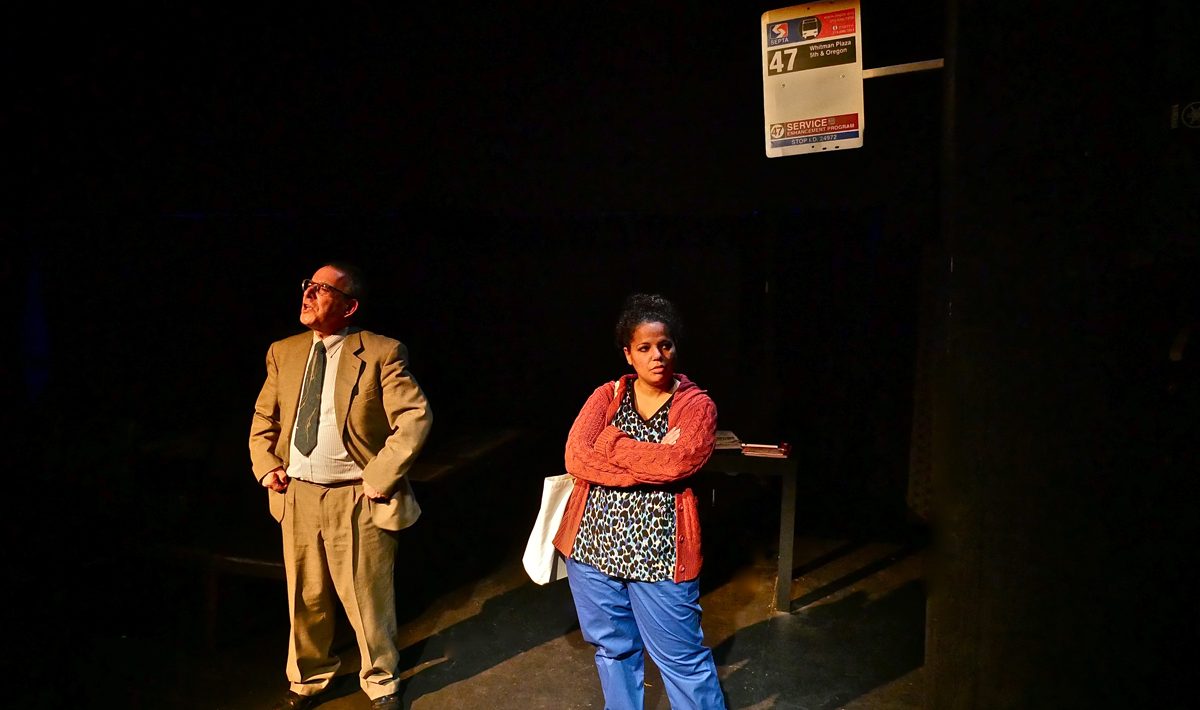By SCOTT BABA
Art and Entertainment Editor

“White Guy On the Bus,” the new play being produced by Women of Words Productions at the Campbell Theater, is probably best described as “complex.” Unabashedly racially and politically charged, the play is in turns thought-provoking, insightful, and infuriating, depending on your point of view and political leaning. But regardless of how you feel about it, it is certainly an engaging piece of theater.
Written by Bruce Graham (you may recall his gentle and poignant “Outgoing Tide” that was produced at the Campbell by Edwin Peabody a couple of years ago), the play spirals around the life of Ray (Avi Jacboson), a well-to-do financial adviser married to Roz (Lisa Luttinger), a teacher who works with underprivileged children of color in the inner city. They spend much of their time with Christopher (Moses Kaplan), a young semi-adopted friend of the family working on his dissertation about the imagery of black men in the media, and his new wife Molly (Lauren Kelley), herself an educator at a school of well-off, predominantly white children. It is probably worth mentioning that all of these characters are white.
In the beginning, the play devotes much of its time bouncing these upper-class white people off of each other as they hold a number of conversations about race, privilege, bias, and the value (or lack thereof) of political correctness. The play especially pits the jaded and cynical (and sometimes crass) Roz against the more liberal, idealistic (and, the play argues, naïve) Molly.
As the play progresses, these philosophical discussions begin to be interspersed with seemingly innocuous scenes of Ray riding the bus in an inner city neighborhood, striking up a friendship over the course of weeks with Shatique (Chelsea Bearce), a black nurse trying desperately to make ends meet in order to provide for her son.
The gentle, almost conversational tone of the play is shattered midway through when racial violence intrudes on Ray’s idyllic life, and the story takes a turn into territory that is much darker, much uglier, and much more engrossing.
To reveal more would spoil the powerful and discomfiting second act, but sufficed to say that much of the intellectual theories discussed earlier in the play are put into brutal practice later on.
Theresa Deed and Gwendolyn Sampson, the founders of the Women of Words theater company, produced the play. Deed and Sampson are both African-Americans, and said that one of the reasons they chose to stage “White Guy On the Bus” was to spark a conversation about race.
“Most of our dramas – especially the ones in February, because it’s Black History Month – we always do something that’s for everyone,” said Deed. “Even though it’s about black people or the things that we’re facing or the things that we’ve dealt with or our accomplishments, I want the audience to leave where there’s a dialogue – there’s communication. I want people that don’t look like me to understand our people. I want them to know that we have true struggles.”

Sampson said she hoped the audience would be able to engage with the characters, even in their darkest moments.
“I think with this play, at least we’ll get people thinking, and hopefully – our hope – is the communication,” Sampson said. “People get to talking, they think about it, they go home, maybe they marinade on it a little bit, and think about, ‘What would I do?’”
Sampson added that she knew people would react strongly to the play. “It’s pretty edgy. It’s not for the fainthearted. I don’t think it’s politically correct at all. I think it’s really in your face, and it’s going to make you do some self-reflecting.”
Directors Kevin Kennedy and Carol Bower-Foote agreed that engaging the audience was a large part of what made the play interesting.
“We want to have a talkback session at some point along the way during the run of this show just to see what really hit these people,” said Kennedy. “We know it’s going to provoke questions – it may provoke anger, it may even provoke some people walking out. I don’t know what to expect. That’s going to be the challenge, but kind of the fun of doing it.”
Story aside, the production itself is a masterpiece. Directors Kevin Kennedy and Carol Bower-Foote make deft use of lighting and placement to fit seven separate locations onto one relatively small stage without cramping or distracting one space from the next.
This comes in handy as the “White Guy On the Bus” is something of a memory play, weaving fluidly in and out of different moments in Ray’s life, not always in a linear way. The tight staging allows for a minimum of scene breaks, letting the moments to slip together naturally, and keeping the momentum building throughout.
The acting is also excellent throughout. Luttinger’s Roz rides a fine line between callousness and vulnerability. Kelley as Molly exudes well-meaning naivete, and Kaplan’s Christopher displays a love for the other characters that is bright and infectious. Bearce as Shatique is probably the most grounded character, more interested in getting through the day than having complicated conversations about race, and her world weariness feels real.
But it is Jacobson who steals the show as Ray, a man who is loving, patient, and even wise – until he isn’t. The transformation of his character over the course of the play could have played as schizophrenic, but in Jacobson’s hands the change instead feels natural and revelatory, like turning over a stone and finding the wet darkness that was always underneath.
“White Guy On the Bus” will make you examine your own opinions about race. It will not be gentle in doing so. It will make you uncomfortable. And maybe that’s necessary. Maybe that’s the best reason of all to go see it.





